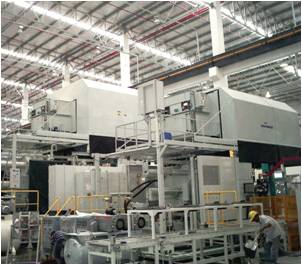Press release
In March 2014 the new WHO report got released: in 2012 around 7 million people died - one in eight of total global deaths – as a result of air pollution exposure. Air pollution continues to pose a significant threat to health worldwide. The mega cities the People´s Republic of China are affected by that: smog hangs heavy over Beijing and Shanghai alone, where children grow up with asthma and other respiratory illnesses. Therefore, high awareness and responsibility towards air pollution is needed more than ever, especially in the industrial sector.
Consequently, today’s industries are facing high restrictions and challenging regulations when planning new investments, especially die casting foundries, as their machines cause greasy, oily and paste-like smoke and aerosols. Both, exhaust air to the outside as well as the air quality inside of buildings, have to be taken into consideration. Because even if the foundry management is not taking into account the consequences which are created for the environment by polluted exhaust air, the company will realise very soon the consequences inside the foundry resulting from low air quality at the working places.
The conventional extraction of the exhaust air to the outside is still common practice in foundries. Here the exhaust air - which has been previously spread in the hall – is captured and (often unfiltered) transported to the outside. This provides a small improvement of the air quality inside the hall, but only means a shift of air pollutants to outdoors. In addition, to let polluted air disperse in the hall first before it is filtered means that greasy aerosols will deposit on products and the expensive machines. High maintenance costs are created. Also the movement of large air amounts is necessary in this case, especially when an air exchange of 10 times the interior volume has been established in practice to create a minimum of air improvement indoors. However, a large amount of exhaust air implicates high energy consumptions for the exhaust and inlet ventilation systems. At the same time, this method causes high heating costs during the cold winter period, because the transported air to outdoors must be replaced with the same amount of fresh air from outside. These facts burden the company with increased operation costs and the environment by high carbon dioxide (CO2) emissions. The use of energy efficient air filtration systems leads in both criteria to a significant improvement in the company's balance sheet. Besides, clean air at the workplace increases the productivity and the motivation at work and also leads to less illness fluctuation of the employees.
The simple solution to avoid air pollution by foundries
Three technical arrangements are necessary to greatly reduce the energy consumption as well as the CO2 emissions of exhaust and supply air systems in die casting foundries and therewith, to create clean air for the productivity of the plant as well as for the society.
1) First important approach is the reduction of the necessary amount of exhaust air through the use of "smart" smoke extraction devices. They enable the detection and extraction of air pollution directly at the source. In this way it is prevented that the indoor air will not be polluted and thus, no suction of a much higher air volume is required. The lower the amount of exhaust air needs to be purified, the lower the energy costs. Tailored hoods or space-saving air curtains over the die casting machines can be placed as smoke extraction hoods. They are optimally adapted in terms of their absorptive capacity to the smoke emissions of the molding cycle. When and how much is extracted, will be decided by the intelligent control system according to current requirements. Even small speed reductions will result in significant energy savings.
2) Furthermore, an optimisation of the filter system in terms of its overall eco-efficiency is of importance. In this review, the power consumption of the filter system, durability and renewability of the filter elements as well as the clean air quality of the filter output has to be reflected in the assessment. The intended filtration system should ensure a high separation-efficiency, but without having the disadvantages of conventional high-efficiency filters. Namely, these are high pressure loss and limited life of the filters by clogging surfaces. Here, electrostatic filters have proven to be the optimal solution: they allow a high degree of separation of oily and greasy emissions such as smoke, dust and fog and ensure due to their design, only low pressure loss and low energy consumption. Since the filter elements are made of stainless steel and aluminum, the electrostatic precipitators are very durable. Through integrated CIP (automatic cleaning system), the maintenance can be kept very low.
3) The third and perhaps most important technical approach is the reduction of heat loss during the cold winter months. This can be done by circulating the clean air inside the hall or by heat recovery systems with highly efficient heat pump technology. The innovative filter technology of today allows cost-saving alternatives to conventional exhaust treatments: today´s most energy efficient method of waste air treatment is the recirculation air mode. Here, through the use of highly efficient filter technology – e.g. two-slot of electrostatic precipitators – a high clean air quality is ensured at the filter output, which allows the filtered exhaust air to be led back into the production hall. The air circulates in the hall and thus, no heat loss is generated through exhaust air. Accordingly, this method has the greatest potential for energy savings as well as the reduction of CO2 emissions. This recirculating air mode system is used in many new built foundries. An interesting alternative to this is the exhaust air mode and a heat recovery system. Here, the filtered air is led outside, but before the heat of the hot exhaust air is recovered by a heat exchanger system with heat pump technology. This exhaust system ensures savings about 80 percent of the energy costs. The combination of proven exhaust filter technology with a new integrated heat recovery system consisting of heat exchanger and high-efficiency exhaust air heat pump makes these savings possible. Heat pumps draw their energy from the relatively warm indoor air, even on cold days. Therefore, this principle achieves an extremely high performance of more than 6 (i.e. from 1 kW electrical power 6 kW of thermal energy can be recovered). Such a system is much more economical than comparable heating systems and allows a direct transfer of the energy (without buffering) to the supply air to be heated.
Take action on air pollution
The energy consumption in foundries is strongly depending on the energy input of the exhaust and supply air systems. High energy consumptions always mean high amounts of CO2 emissions. Through the use of energy-efficient exhaust air filtration systems the air gets clean and significant reductions in carbon dioxide emissions can be done. Die casting foundries can easily improve the company´s “Carbon Footprint” and make an important contribution to climate protection. Therefore, a change in thinking for each foundry is worthwhile. The new technology shows that environmental compatibility and economy are not contradictory, but actually complement and reinforce each other. Investing in an energy efficient exhaust air system pays for itself: It gives the foundry significant savings and competitive advantages and improves the "ecological footprint" of the company through significant reductions in CO2 emissions. Energy-efficient exhaust filtration systems like the ones from KMA help metal casting facilities achieve ISO 9000 and ISO 14000 certifications.
For further information about eco-efficient exhaust air filtration systems meet KMA Environmental Technology (Shanghai) Co., Ltd. on July 22 – 24 at CHINA DIECASTING 2014, in Shanghai New International Expo Centre (SNIEC). Booth number D31-3.
Recirculating air mode:
In the recirculating air mode, the
exhaust air is highly purified so that it can be fed back into the work area
(see chart at the right). Therewith, there is no heat loss during the cold
winter months. Accordingly, the recirculating air mode contains the highest
potential of energy savings.
KMA
extraction hood and filtration system UV 15000/EE and UV 10000/EE in a
recirculating air mode
Exhaust air mode:
Operating in an exhaust air mode, a
heat recovery system can be integrated, which extracts the heat out of the
exhaust air before it is conducted outdoors. The recovered heat can be used for
follow-up processes (e. g. to heat up the incoming cold air during the winter
months).






